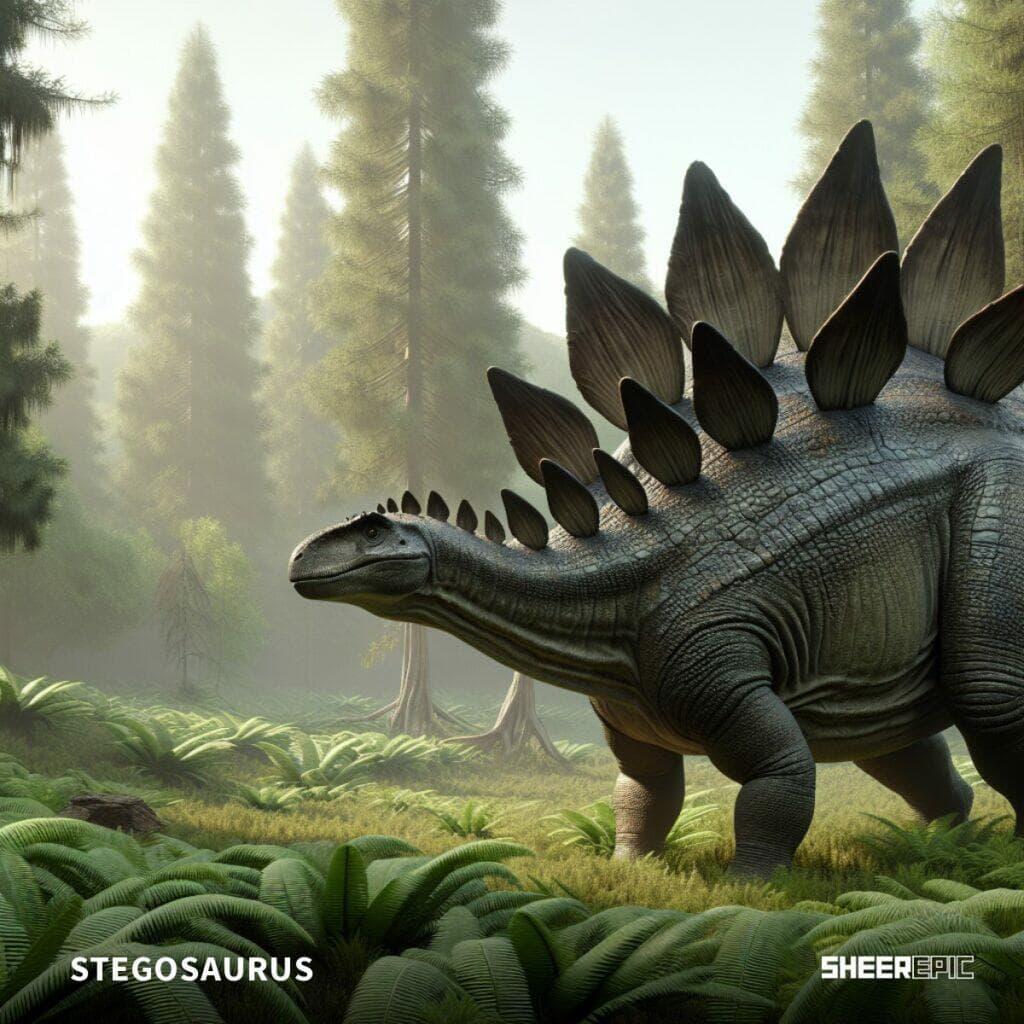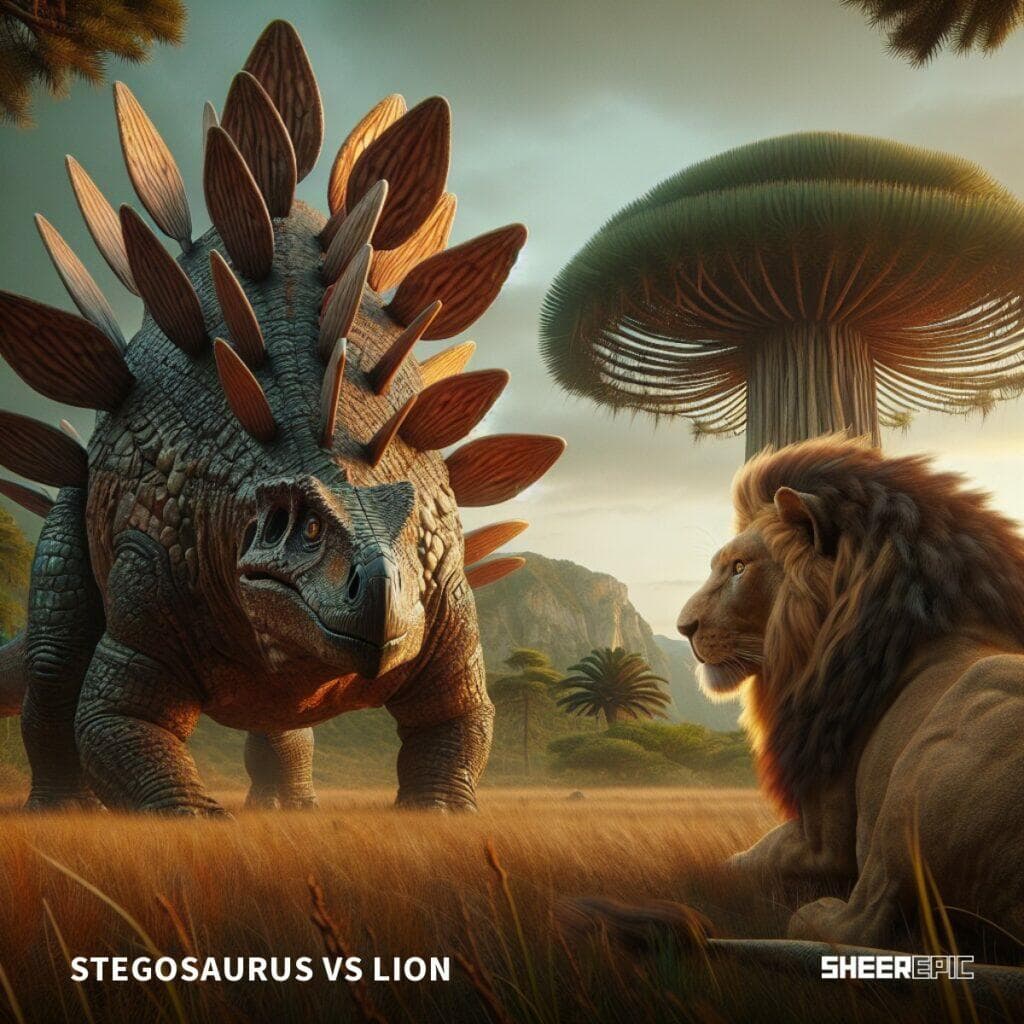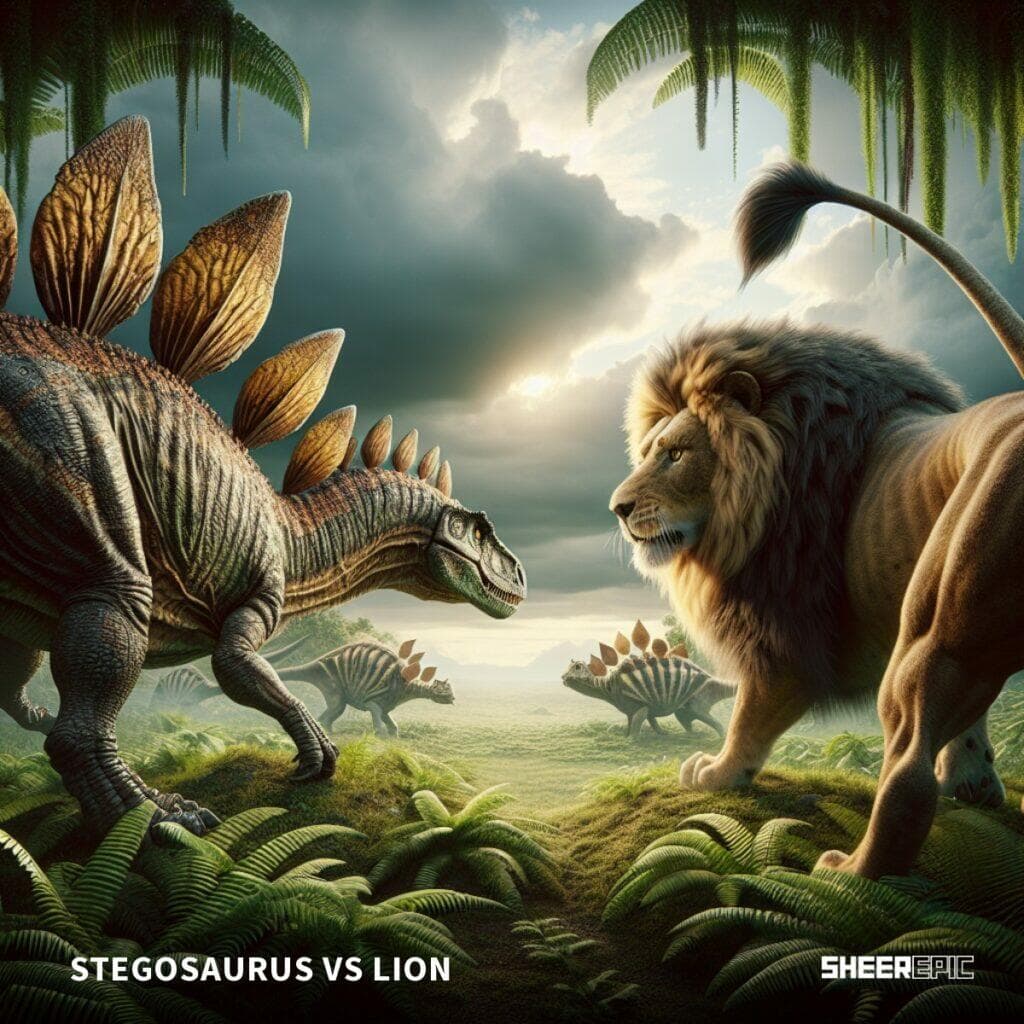The Stegosaurus and the lion are two iconic and powerful animals that have intrigued people for generations. However, they existed millions of years apart, with the Stegosaurus roaming the earth during the Late Jurassic period while lions are a contemporary species.
Despite this vast difference in time, it’s interesting to explore what would happen if these two creatures were to face off in a hypothetical battle.
The Stegosaurus was a large, herbivorous dinosaur known for its distinctive row of kite-shaped plates along its back and spiked tail, which served as its primary defense mechanisms.
On the other hand, the lion is a carnivorous mammal and an apex predator, famous for its strength, agility, and social hunting tactics.
Key Takeaways
- Stegosaurus and lions thrive in distinct periods and ecosystems, making any comparison speculative.
- The physical characteristics, defense mechanisms, and social behavior of both creatures contribute to their strengths and weaknesses.
- Environment and other unpredictable factors play a role in determining the potential outcome of this hypothetical encounter.
Table of Contents
Comparison
Comparison Table
| Attribute | Stegosaurus | Lion |
|---|---|---|
| Size | 9 meters (30 feet) long | 1.8 meters (6 feet) long |
| Weight | 4-5 metric tons | 160-250 kg (350-550 lbs) |
| Diet | Herbivorous | Carnivorous |
| Speed | 15.3-17.9 km/h (9.5-11.1 mph) | 80 km/h (50 mph) |
| Defensive features | Back plates and spiked tail | Claws and teeth |
| Time period | Late Jurassic (155-145 million years ago) | Modern times |

The Stegosaurus was a large, herbivorous dinosaur with distinctive kite-shaped upright plates along its back, and spiked tail, used for defense against predators like the Allosaurus. It lived in the Late Jurassic period, around 155 to 145 million years ago.
The Stegosaurus measured up to 9 meters (30 feet) long and weighed around 4-5 metric tons, making it quite larger and heavier than a modern-day lion.
This dinosaur had a slow speed of around 15.3-17.9 km/h (9.5-17.9 mph), limiting its ability to evade predators, although its strong tail and defensive spikes provided some protection.

On the other hand, the lion is a powerful carnivore that lives in modern times.
With a body length of about 1.8 meters (6 feet) and a weight between 160-250 kg (350-550 lbs), lions are significantly smaller and lighter than the Stegosaurus.
However, they are much faster, reaching speeds of up to 80 km/h (50 mph). This enables them to chase down and capture prey effectively.
In a one-on-one battle, a lion’s primary weapons are its sharp claws and teeth, designed for gripping and tearing flesh.
When comparing the two, it is important to consider both the physical characteristics and defensive capabilities of each species.
While the Stegosaurus has impressive size and a powerful spiked tail, its slow speed and lack of agility could be a disadvantage against the highly predatory and agile lion.
Likewise, although a lion is fast and aggressive, it’s significantly smaller in size and weight, suggesting it would struggle to defeat the heavily armored Stegosaurus.
Physical Characteristics
The Stegosaurus was an herbivorous, four-legged dinosaur that lived during the Late Jurassic period, around 155 to 145 million years ago, in what is now western North America.
It is instantly recognizable by its distinctive double row of kite-shaped dermal plates along its back and the sharp spikes on its tail.

In terms of size, the Stegosaurus was a large dinosaur with a length of up to 9 meters (30 feet) and a height of around 4 meters (14 feet) at the highest point of its back. The estimated weight of a Stegosaurus ranges between 4.5 to 7 tons.
This massive frame was supported by a robust vertebral column and stout limbs.
The most striking feature of the Stegosaurus was its dermal plates. These bony plates, also known as osteoderms, served as a passive defense mechanism against predators and possibly played a role in thermoregulation.
The plates were arranged in two alternating rows, with the largest plates found near the animal’s hips. Their size and shape varied, with some plates reaching up to 60 centimeters (24 inches) in height and 60 centimeters (24 inches) in width.
Towards the end of its tail, the Stegosaurus had two pairs of elongated tail spikes, also known as thagomizers. These spikes could measure up to 60 to 90 centimeters (24 to 35 inches) in length, making them a powerful weapon against potential threats.
Fossil evidence of the Stegosaurus provides valuable insights into its morphology and characteristics. The most complete Stegosaurus skeleton ever found was discovered in 2003 in Wyoming, USA, and has contributed greatly to our understanding of this iconic dinosaur.
In contrast, the lion is a large carnivorous mammal and the second-largest cat species, with a body length of 1.5 to 2.5 meters (5 to 8 feet) and a height of around 1.2 meters (4 feet) at the shoulder. Adult male lions typically weigh between 150 to 250 kilograms (330 to 550 pounds), while females usually weigh between 110 to 180 kilograms (242 to 400 pounds). Although lions possess powerful forelimbs, sharp claws, and strong jaws, they are significantly smaller than the Stegosaurus.
Diet and Hunting
The Stegosaurus was a herbivorous dinosaur, mainly feeding on plants during the Late Jurassic period. This creature possessed a small head with a toothless beak that allowed it to graze on low-lying vegetation, utilizing its peg-like teeth to break down the plant matter Stegosaurus. As it was not a predatory dinosaur, it lacked the necessary skills and features to hunt down prey.
On the other hand, the lion is a top carnivorous predator with highly developed predatory behaviors. It is an ambush predator, using stealth to get close to its prey before pouncing on them with speed and force. Lions prey on various animals, including zebras, antelopes, and wildebeest Lion hunting. Their powerful bodies, strong jaws, and sharp claws are all adaptations that facilitate their hunting success.
In terms of hunting capabilities, the Stegosaurus and the lion are vastly different. The former was a herbivore with limited means of protection, relying on its armored back plates and tail spikes for defense. In comparison, the lion possesses sophisticated and complex predatory tactics.
A carnivorous dinosaur that would have had a fairer matchup against a lion would be a smaller, agile predator, such as the Velociraptor, which exhibits more efficient predatory behavior.
Defense Mechanisms
The Stegosaurus and the lion exhibit distinctive defense mechanisms that contribute to their survival in their respective environments. The Stegosaurus is an herbivorous, four-legged, armored dinosaur from the Late Jurassic period, characterized by its unique upright plates and spiked tail called a thagomizer. On the other hand, the lion is a carnivorous mammal known for its strength, agility, and sharp claws.
The Stegosaurus’ primary defense mechanism lies in its spiked tail, which contains four long, sharp spikes known as the thagomizer. This structure is capable of inflicting serious damage on potential predators. Apart from the thagomizer, the Stegosaurus also has a series of scutes, or bony plates, along its back that provide additional protection against attacks.
In contrast, the lion’s defensive capabilities are intertwined with its offensive skills due to its nature as a predator. Lions possess sharp claws on their forelimbs and strong jaws, enabling them to fiercely attack, hold, and immobilize their prey. Additionally, their thick skin and dense fur offer some degree of protection from injuries during combat with other animals.
Although the Stegosaurus may appear to have a stronger and more effective defense mechanism due to its armored body, it is essential to consider the context and environment in which these two species interact. The lion is adapted to hunting and fighting in its ecosystem, whereas the Stegosaurus was designed to feed on vegetation and ward off attackers.
Intelligence and Social Behavior
Stegosaurus, a herbivorous dinosaur from the Late Jurassic period, lived in a herd structure, which provided safety in numbers against potential predators. In contrast, lions are predatory mammals that live and hunt in packs called prides. These social structures play a significant role in the intelligence and fighting capabilities of each species.
Stegosaurus had a small brain relative to its body size, with estimates placing it at around 80 grams for an animal weighing over 4.5 metric tonnes. Nevertheless, research has shown that dinosaurs were far from unintelligent, contrary to the old belief that their small brains indicated limited cognitive abilities. While Stegosaurus might not have been as smart as some of the larger-brained predators of its era, it still had to rely on adaptive behaviors and cooperation within the herd for survival.
On the other hand, lions are more adept at fighting, with their pack mentality and coordination playing a significant role in their hunting success. This coordination requires higher cognitive abilities, such as communication, understanding social hierarchy, and cooperation among pride members. As a result, lions are generally considered smarter than Stegosaurus when it comes to decision-making and problem-solving in survival situations.
Key Factors
When comparing a Stegosaurus and a lion, several key factors must be considered in order to determine which animal would have the upper hand.
First, we must examine their speed. While the exact running speed of a Stegosaurus is not known, it is believed to have been relatively slow due to its massive size and stout limbs. On the other hand, lions are known for their impressive speed, with the ability to sprint at speeds of up to 50 miles per hour.
In terms of bite power, the lion has a clear advantage. With a bite force of around 650 psi, lions are well-equipped to take down large prey. A Stegosaurus, being an herbivorous dinosaur, would not have had as powerful a bite force. However, its distinctive upright plates and spiked tail could have offered defensive capabilities against potential predators.
Another factor to consider is their reach and agility. As a quadrupedal creature, the Stegosaurus would have had a low center of gravity, allowing it to remain stable amid physical encounters. Lions, on the other hand, are not only fast but also agile and muscular, able to leap great distances and maneuver their bodies with ease. This nimbleness would have been an advantage in a confrontation.
As an offensive powerhouse, the lion, being an apex predator and carnivore, has numerous tools at its disposal. Its sharp claws, strong jaws, and serrated teeth allow it to deliver powerful puncture attacks. The Stegosaurus, while not a predator, would have relied on its tail spikes to inflict damage.
It is important to note that comparing a Stegosaurus and a lion directly is difficult due to their vastly different habitats and ecosystems. For example, the Stegosaurus lived during the Late Jurassic period alongside other large dinosaurs, including the Tyrannosaurus rex (although the T-Rex appeared much later than the Stegosaurus), whereas the lion is a modern species. Thus, while we can evaluate their abilities based on their physical traits and known behaviors, it is essential to recognize the limitations of such comparisons.
Who Would Win?
In a hypothetical battle between a Stegosaurus and a lion, several factors would come into play. The Stegosaurus, a four-legged herbivorous dinosaur, lived in the Late Jurassic period and was characterized by its distinctive upright plates along its back and spikes on its tail source. Conversely, the lion is a contemporary big cat, well known for its predatory prowess and strength.
When considering the way these two animals would engage in a fight, it is essential to take into account their different offensive and defensive capabilities. The Stegosaurus would have relied on its spiked tail, known as a thagomizer, to fend off attackers and inflict damage. On the other hand, the lion is known for its speed, powerful jaw, and razor-sharp claws, which are all instrumental in hunting and attacking prey.

Size also plays a critical role in determining the potential outcome of a battle between the two species. A fully grown Stegosaurus could reach lengths of up to 30 feet and weigh around five tons. In contrast, an adult male lion typically measures approximately 12 feet in length and weighs around 420 pounds, making it significantly smaller than the Stegosaurus.
When examining predatory behavior, the lion has a clear advantage due to its carnivorous nature and history of hunting large prey. However, the Stegosaurus, despite being a herbivore, would have undoubtedly faced threats and battles with other aggressive dinosaurs during its time. Evidence of such dinosaur death duels has been observed in fossil records, such as the popular Allosaurus vs. Stegosaurus battles source.
Relevant Entities
The Stegosaurus, a well-known dinosaur, roamed the Earth during the late Jurassic period. As a large herbivorous sauropod, it was characterized by its distinctive plates along its back and spiked tail, both used as defense mechanisms. Stegosaurus fossils have provided valuable insights for paleontologists studying dinosaurs, specifically in relation to their size, diet, and habitat.
The lion, on the other hand, is a large carnivorous mammal and an apex predator, known as the “king of the jungle.” With its powerful jaws, sharp teeth, and unparalleled hunting abilities, the lion sits at the top of the food chain in the African Savannah. The history of the Detroit Lions showcases its prowess and symbolism in popular culture.
Dinosaurs and mammals differ in many ways, from their anatomy to geographical distributions. The Jurassic and Cretaceous periods witnessed the rise of dinosaurs, while mammals emerged in the late Cretaceous period. Therefore, a hypothetical encounter between a Stegosaurus and a lion would be a clash between species separated by millions of years.
Fossils of other dinosaurs like Triceratops and Velociraptor, as well as dino-birds and theropods like the T-Rex, help us understand the immense diversity of reptiles that lived during these prehistoric times. While some modern reptiles still exhibit features of their ancient ancestors, today’s world is mostly populated by mammals, varying from the smallest rodents to the largest whales.
Comparing a Stegosaurus and a lion in terms of their strengths, weaknesses, and abilities may seem absurd in the real world, but the concept of pitting them against each other has often been popular in the realm of fiction. Various video games and fictional works, as well as experiments like the Animal Face-Off, bring these creatures together in imaginative battles.
In conclusion, the comparison between a Stegosaurus and a lion encompasses aspects of paleontology, biology, and pop culture. The contrast between these two iconic creatures highlights the extraordinary tapestry of life that has existed throughout the Earth’s history.
Frequently Asked Questions
What factors determine the winner between a Stegosaurus and a lion?
There are several factors that could determine the outcome of a battle between a Stegosaurus and a lion. These include size, strength, agility, and defensive and offensive capabilities. The environment and circumstances of the encounter would also play a role in determining the winner.
How does the size and strength of a Stegosaurus compare to a lion?
A Stegosaurus was a large, plant-eating dinosaur that lived around 155 to 145 million years ago. It was easily recognizable by the double row of kite-shaped plates along its back and spikes on its tail. In comparison to a lion, Stegosaurus was much larger and heavier. A fully grown Stegosaurus could weigh up to 5 metric tons, while an adult male lion typically weighs around 190 kilograms.
What were the defensive capabilities of a Stegosaurus?
The Stegosaurus had several defensive capabilities, including the distinctive upright plates along their backs and spikes on their tails. These features not only gave the dinosaur a unique appearance but also served as protection against predators. The sharp, sturdy spikes (or thagomizers) on the tail were a formidable defensive weapon that could inflict severe injuries on an attacker.
How effective would a lion’s hunting techniques be against a Stegosaurus?
A lion’s usual hunting technique involves stalking its prey, using stealth and teamwork with other lions in the pride, and going for the throat or neck of the prey. Since the Stegosaurus was much larger than a lion and had defensive features, it would be challenging for a lion to hunt the dinosaur using its typical tactics. Moreover, lions did not coexist with dinosaurs, which means they would not have the necessary knowledge or adaptations to deal with a Stegosaurus.
In a hypothetical battle, what advantages would a lion have over a Stegosaurus?
Despite the size and defensive capabilities of a Stegosaurus, a lion would still have some advantages over the dinosaur in a hypothetical battle. Lions are known for their agility, speed, and teamwork, while Stegosaurus was a relatively slow-moving herbivore. An intelligent and cunning lion might be able to exploit weak points in the Stegosaurus’s armor or use its agility to avoid being struck by the tail spikes.
What are some examples of other prehistoric or modern animal battles?
While hypothetical battles between prehistoric and modern animals might provide an interesting topic of conversation, it is essential to note that such confrontations rarely occurred in reality due to the differences in their periods of existence. However, prehistoric creatures, such as the predatory Tyrannosaurus rex and the armored Triceratops, are speculated to have engaged in battles during their time. In the modern world, animal confrontations and battles can be seen in the context of predation, territory defense, and competition for resources.


